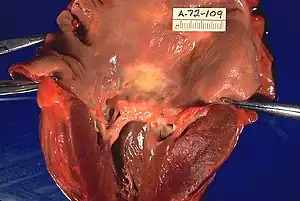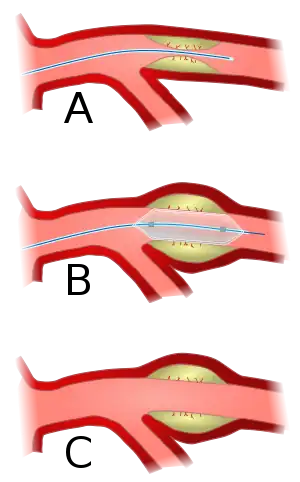Cardiovascular disease in Australia

Cardiovascular disease, including heart disease, is a major cause of death in Australia.[1] Heart disease is an overall term used for any type of Cardiovascular disease that affects the heart reducing blood supply to the heart. It is also often referred as Cardiac disease and Coronary heart disease. It is generally a lifelong condition where damage to the artery and blood vessel cannot be cured.[2]
Cardiovascular disease (CVD) continues to have a major impact on the health of Australians in terms of prevalence, mortality, morbidity, burden of disease and expenditure. From 2007–08, an estimated 3.4 million Australians were diagnosed with CVD.[3] Cardiovascular disease remains Australia's leading cause of death. In 2009, 46,106 deaths in Australia were directly linked with CVD (21,935 males and 24,171 females); this figure represents a total of 33% of all deaths in Australia.[4] It was reported in 2010 that almost 16% of the total projected burden of disease was a result of CVD.[5] This then made individuals with CVD susceptible to co-morbid conditions later in life, making them "at risk" for depression and anxiety.
Types of heart disease
There are number of conditions that involves the heart such as:
- Heart failure – damaged heart muscles, therefore, it becomes too weak to pump blood to the body (Newton & Joyce, 2012, p. 74).
- Coronary heart disease – when plaques deposits in the coronary artery narrowing the artery reducing the flow of blood to the heart muscle (Newton & Joyce, 2012, p. 75)
- Stroke – blocked blood vessel in the brain resulting in the brain tissues not receive oxygen (Newton & Joyce, 2012, p. 76)
- Myocardial infarction (heart attack) – blockage in the arteries that completely blocks the blood flow to the heart (Newton & Joyce, 2012, p. 76)
- Peripheral vascular disease – the flow of blood supply is slow or absent in veins and arteries in the limbs (Newton & Joyce, 2012, p. 72)
Symptoms and signs

According to Chenzbraun (2010), symptoms of the heart disease varies, and should not be ignored. The symptoms of heart disease are not always intense and varies according to factors such as age and gender. The most common symptoms of heart disease is:
- Chest pain – uncomfortable sensation of pressure in the chest often entered under the breastbone.
- Dizziness – loss of consciousness
- Fatigue – feeling tired at all times (mostly among women)
- Nausea – swelling in the abdominal area can interfere with digestion, resulting in lack of appetite.[6]
- Shortness of breath – irregular pulse and skip of heartbeat
- Swelling – accumulation of fluids in the body causing the feet, abdomen and leg to swell.
Risk factors
Smoking
This is a major risk factor of heart disease resulting in death. The rate of smoking is low in Australia according to the health survey: 14% of women and 18% of men being daily smokers (Nichols, 2014).
Physical inactivity
58% of Australians lack physical activity. Those who undertake low levels of physical activity are at higher risk of developing heart disease. Men were classified as moderately active than women (Nichols & Peterson, 2014).
Excessive alcohol consumption
Alcohol plays a huge role in Australian culture and its social circumstance. According to the Australian Bureau of statistics, 87.6% of males and 77.3% of females had consumed alcohol in the past year. Alcohol consumed at a limit, reduces the risk of developing heart disease.
Overweight
Being overweight and obese is very common in Australia especially children and teens. Almost 69.7% of male and 55.7% of female are overweight. The rate for both men and women of obesity is 27.5% (Australian Bureau of statistics). It is one of the leading cause of heart disease and cardiovascular disease.
High blood pressure
High blood pressure (hypertension) causes stress to the heart and its function that leads to heart disease. Males experience heart disease caused by hypertension than women. One in five Australians with high blood pressure suffers from heart disease (Nichols, 2014).
Prevention
A key step to prevent any type of heart disease is addressing the risk factors. Such as not smoking or use of drugs, regular exercising, have healthy diet, maintain healthy weight and have regular health screening to check up on blood pressure. These lifestyle changes reduces the risk of developing heart disease (Wood & Gordon, 2011).
Treatment

Prescribed medications are given to those suffering to help improve blood flow, low blood pressure and to relax blood vessel walls.
A non-surgical procedure called, Angioplasty, could be done to help dilate the narrowed arteries.
Coronary artery bypass surgery is also another way to treat coronary heart disease.
Although there are treatments available to treat heart disease, it is a lifelong condition restricting some daily lifestyle routine and incurable.
Epidemiology
Heart disease is the leading cause of death in Australia.[7] In 2007-8 about 3.5 million people were diagnosed with heart disease (especially cardiovascular disease). Although there are significant advances in the treatments, heart disease still remains the lead cause of death in Australia especially with people in lower socioeconomic groups (AIHW, 2011).
The number and rate of deaths from CVD have fallen considerably from the peak levels experienced in the late 1960s and early 1970s when CVD was responsible for around 60,000 deaths annually, or roughly 55% of all deaths each year.[8] These major gains have been attributed to a combination of research, improvements in prevention and detection of cardiovascular disease, and better clinical management of people with the disease. There is a close interrelationship between CVD and other important chronic conditions, including diabetes and chronic kidney disease.[9]
Cardiovascular disease kills one Australian every 11 minutes, and 3·4 million of the country's population are affected, with the Indigenous Australians having a 30% higher rate. In their lifetime, 1·5 million Australians are estimated to have diabetes and one in six Australians are suspected to have a stroke. The Baker Heart and Diabetes Institute, based in Melbourne, is one of the most well known cardiovascular disease research institutes.
One of the studies directed by an Australian-Dutch research team, led by, Karin Jandeleit-Dahm from Harald Schmidt from Maastricht University, Netherlands, has identified the role of an enzyme which accelerates the development of diabetic atherosclerosis. Researchers were able to substantially reduce the development of artery plaques by suppressing or inhibiting this enzyme with a new drug, which will allow prevention and treatment of cardiovascular disease in people with diabetes.
Another team, led by Bronwyn Kingwell,[10] Head of the Baker Institute's Metabolic and Vascular Physiology, have found a new use for an old drug. The researchers found that after taking the standard anti-hypertensive drug Ramipril, patients with peripheral arterial disease (PAD), which restricts mobility due to leg pain, enjoyed a longer and less painful time on their feet. For some patients, this could be the difference between living independently and living under the care of others for the rest of their lives.[11]
See also
- Diabetes in Australia
- Health in Australia
- Baker Heart and Diabetes Institute
References
- ↑ Nichols, M., Peterson, K., Alston, L. & Allender, S. (2014). Australian heart disease statistics. Melbourne: National Heart Foundation of Australia.
- ↑ Bishop, T. (2010). Heart disease. Primary Health Care, 20(3), 12.
- ↑ "Cardiovascular Disease". Australian Institute of Health and Welfare. Australian Government. 2015. Archived from the original on 2015-04-15. Retrieved April 6, 2015.
- ↑ Waters, A.M.; Trinh, L.; Chau, T.; Bourchier, M.; & Moon, L. (2013). "Latest statistics on cardiovascular disease in Australia". Clinical and Experimental Pharmacology and Physiology. 40 (6): 347–356. doi:10.1111/1440-1681.12079. PMID 23517328. S2CID 37524394.
- ↑ "Cardiovascular Disease". Australian Institute of Health and Welfare. Australian Government. 2015. Archived from the original on 2015-04-15. Retrieved April 4, 2015.
- ↑ "LOSS OF APPETITE/NAUSEA". heartfailurematters.org. Heart Failure Association of the ESC. Retrieved 18 February 2017.
- ↑ Craig Butt (6 April 2015). "Australian researchers help find way to regrow heart muscle". Brisbane Times. Fairfax Media. Retrieved 6 April 2015.
- ↑ "Fact Sheet" (PDF). Heart Research Australia. Retrieved 2015-04-13.
- ↑ AIHW website Accessed 21 April 2009 12.35
- ↑ "Staff biography, Professor Bronwyn Kingwell". Baker Heart and Diabetes Institute.
- ↑ Kirby, Tony (2 May 2014). "Profile:Australia's Baker Heart Diabetes Institution". The Lancet. 383 (9927): 1452. doi:10.1016/s0140-6736(14)60704-2. PMID 24779053. S2CID 30552737.
Bibliography
- AIHW. (2011). Cardiovascular disease: Australia facts. Canberra: AIHW Retrieved from http://www.aihw.gov.au
- Chenzbraun, A. (2010). Heart disease. Oxford University Press Retrieved from http://www.eblib.com
- Newton, J, T. & Joyce, A, P. (2012). Human perspectives 2AB (6th Ed). Australia & New Zealand: E. Gregory.
- Wood, J., & Gordon, P. (2011). Preventing heart disease in women: The NP's role. The Nurse Practitioner. doi: 10.1097/01.NPR.0000410275.21998.b5